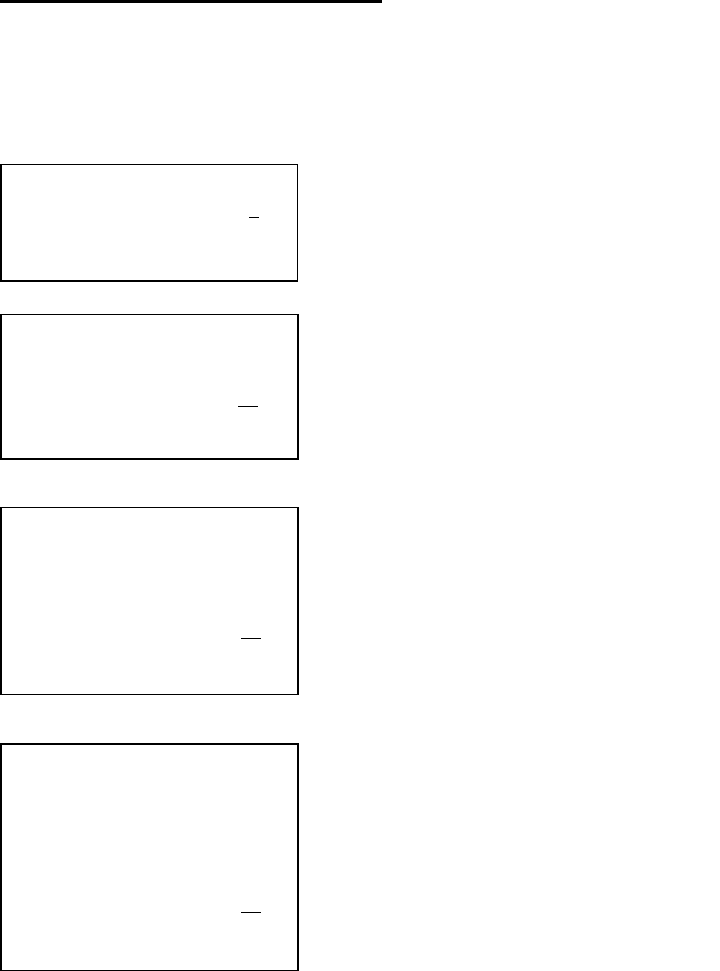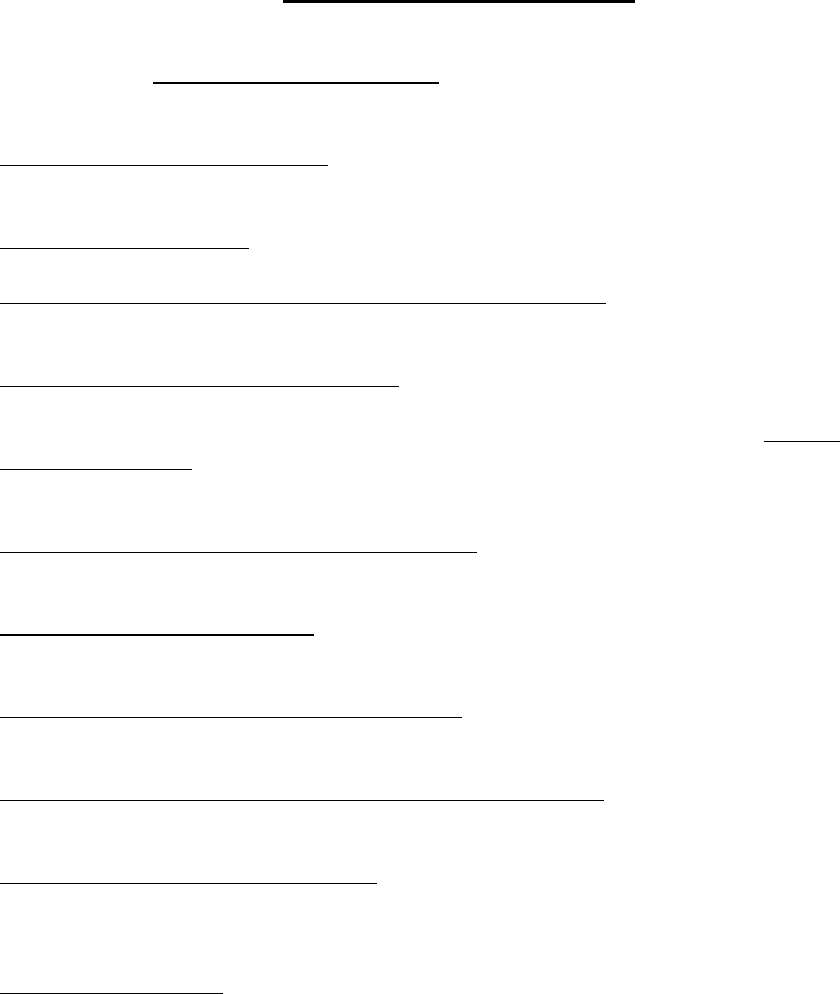
NATIONAL INSTITUTE FOR CERTIFICATION IN ENGINEERING TECHNOLOGIES
®
A division of the National Society of Professional Engineers
PROGRAM DETAIL MANUAL
Field Code: 022 Fourth Edition
Subfield Code: 01 January 2013
Land Management and Water Control
EROSION AND SEDIMENT CONTROL
Please check NICET’s website (www.nicet.org) to
make sure you have
the most recent edition of this document.
Effective upon issuing a new edition of any program detail manual,
all previous editions of that program detail manual become obsolete.
This manual may be freely copied in its entirety.

IMPORTANT INFORMATION
The Institute occasionally makes changes in its certification programs that will significantly affect
the currency of individual program detail manual. These changes could include any or all of the
following:
•
deletion, modification, or addition of work elements
•
modification to the Examination Requirements Chart
•
modification to crossover work element credit
•
changes to the work experience requirement
•
changes to the verification requirement
Such changes could affect the requirements for certification. Therefore, if this manual is more than a year old, NICET highly
recommends that you check www.nicet.org (or, if you don’t have access to the Internet, call NICET at 888-476-4238) to
make sure that you have the current edition of the Program Detail Manual before applying for an examination. The date of
publication of this manual is November 2012.
It is the responsibility of all applicants to make sure they are using a current manual.
This fourth edition of the Erosion and Sediment Control program detail manual contains the
following substantive change from the third edition.
•
Work element #11011, “Basic Metric Units and Conversions,” is no longer
mandatory for certification at Levels II, III and IV.
All test records for an individual certification area will be purged from the
database after 5 years if no further testing is done in that certification area
and you are not certified in that certification area. See Policy #26 on our
website (www.nicet.org).
DELETION OF TEST RECORDS
Whenever an exam requirement changes, individuals who are already certified and do not intend to upgrade
their level of certification do not need to comply with any changes for the level(s) of certification they have
already been awarded.
Individuals who wish to upgrade must satisfy any “new” exam and/or certification requirements for the
higher level once the posted deadline and grace period for satisfying the “old” exam and/or certification
requirements has been passed (December 31, 1997).
KEEP YOUR
MANUALS
CURRENT
CHANGES
TO THIS
MANUAL
FIELD OF LAND MANAGEMENT AND WATER CONTROL
SUBFIELD OF EROSION AND SEDIMENT CONTROL
TABLE OF CONTENTS
GENERAL INFORMATION AND PROGRAM DESCRIPTION ..........................................................................1
CERTIFICATION REQUIREMENTS ....................................................................................................................1
WORK ELEMENT DESCRIPTION ........................................................................................................................ 2
FIELD CODE AND WORK ELEMENT IDENTIFICATION NUMBERS ............................................................ 2
WORK ELEMENT SELECTION FOR AN INITIAL EXAM ................................................................................ 3
CROSSOVER WORK ELEMENTS ........................................................................................................................ 4
EXAMINATION REQUIREMENTS CHART ........................................................................................................ 5
WORK ELEMENT SELECTION FOR ALL SUBSEQUENT EXAMS ................................................................. 6
VERIFICATION OF WORK ELEMENTS ............................................................................................................. 6
WORK EXPERIENCE REQUIREMENT ............................................................................................................... 6
LEVEL IV WORK EXPERIENCE REQUIREMENT ............................................................................................. 7
EARLY TESTING OF LEVEL IV WORK ELEMENTS ........................................................................................ 7
PREPARATION FOR TESTING............................................................................................................................. 7
TRAINING COURSES ............................................................................................................................................ 7
EXPIRATION OF CERTIFICATE ..........................................................................................................................8
RECERTIFICATION ...............................................................................................................................................8
WORK ELEMENT LISTING
Level I General Work Elements ................................................................................................................. 9
Level I Special Work Elements ..................................................................................................................10
Level II General Work Elements ................................................................................................................10
Level II Special Work Elements .................................................................................................................12
Level III General Work Elements ..............................................................................................................14
Level III Special Work Elements ...............................................................................................................14
Level IV General Work Elements ..............................................................................................................16
Level IV Special Work Elements ...............................................................................................................17
PERSONAL TALLY WORKSHEET ......................................................................................................................18
SELECTED GENERAL REFERENCES .................................................................................................................19
SAMPLE SCORE REPORT ....................................................................................................................................21

1
complete the written examination requirement
work element verification by the immediate supervisor
appropriate employment history
technician recommendation by an acceptable recommender (required at Level III)
GENERAL INFORMATION
This Program Detail Manual contains the information needed to apply for the NICET certification examination in the
Erosion and Sediment Control subfield of Land Management and Water Control Engineering Technology.
This manual does not contain all of the rules and procedures for obtaining certification. For this, you must refer to the
website (www.nicet.org).
National Institute for Certification
in Engineering Technologies (NICET)
1420 King Street, Alexandria, Virginia 22314-2794
1-888-476-4238 (staff response – 8:30am to 5pm Eastern Time)
(voice mail system at all other times)
1-703-548-1518 (local number)
www.nicet.org
PROGRAM DESCRIPTION
This certification program was designed for engineering technicians involved in all phases of erosion and sediment
control work. Areas covered include knowledge of soils, the erosion process, small watershed hydrology, hydraulics of basic
water control structures, sedimentation process, principles of erosion and sediment control, construction practices,
construction inspection, and field investigation reports.
This program became operational in 1988. Development of the program was initiated in 1986 with technical assistance
provided by the Pennsylvania Department of Environmental Resources.
CERTIFICATION REQUIREMENTS
Certification candidates must meet the following criteria:
Simply passing the examination does not guarantee certification. All other components MUST be accepted and
approved in order to achieve certification.
Level I is designed for entry-level technicians with very limited relevant work experience in this technical subfield. The
Institute recommends that persons with eighteen or more months of relevant work experience set their initial certification
goal at Level II. Certification at Levels II and III does NOT require prior certification at Level I. The Examination
Requirements Chart on page 5 lists the actual examination requirements for certification at Levels I, II, and III in the subfield
of Land Management and Water Control.

2
WORK ELEMENT DESCRIPTION
The typical job duties and associated responsibilities of erosion and sediment control technicians have been broken down
into discrete work elements which form the basis for an evaluation of the candidate’s knowledge. Each work element is
written in sufficient detail to permit candidates who have the appropriate work experience to make reasonable assumptions
about the types of questions likely to be asked.
In addition, the supervisor verifying the experience of the candidate should be able to interpret the scope of the activities
associated with each work element.
FIELD CODE AND WORK ELEMENT IDENTIFICATION NUMBERS
In order for NICET to prepare individualized examinations for each applicant, identification numbers have been assigned
to each technical field and to each work element. Each technical field is represented by a 3-digit number. The technical field
code number of Land Management and Water Control is 022.
The identification number assigned to each work element is 5 digits long. The first digit identifies the technical subfield
within the field of Land Management and Water Control Engineering Technology:
(1) Erosion and Sediment Control
At present, there are no additional subfields operational in this technical field. Subfields under consideration for future
development in this field include certification programs covering hydro projects.
The second digit identifies the level (Levels I through IV) and the work element type (General or Special):
GENERAL WORK ELEMENTS SPECIAL WORK ELEMENTS
(1) Level I General (2) Level I Special
(3) Level II General (4) Level II Special
(5) Level III General (6) Level III Special
(7) Level IV General (8) Level IV Special
The third, fourth and fifth digits identify the individual work element within each category.
An example of this numbering system is illustrated below for work element number 022/15001:
This eight-digit identification number is needed when using the application form to request an examination or provide
work element verification.
Technical Field Code: 022 (Land Management and Water Control)
Subfield: 1 (Erosion and Sediment Control)
Level/Type: 5 (Level III General)
Work Element Number: 022/15001 (Field Code Number/ 5-Digit Work Element ID Number)

3
WORK ELEMENT SELECTION FOR AN INITIAL EXAM
1. Refer to Examination Requirements Chart on page 5.
2. Select the appropriate box for the level of certification desired.
3. Note the number/type of work elements required for certification, by category, as shown in the selected box.
4. Turn to the Work Element Listing section and carefully select work elements from the required categories, paying
attention at each level to whether they are classified as General or Special work elements. It is also very important that
you read and understand the subject work element descriptions. When possible, select a few extra in each category so
that failing one or more work elements leaves enough passed work elements to satisfy the examination requirements.
5. The maximum number of work elements for any single examination sitting is 34, due to time restrictions.
6. The Institute recommends that the maximum number of work elements (34) be selected for each examination. This
provides the greatest opportunity for successful completion of the examination requirements with the least number of
subsequent examinations. Recognize, however, that all elements selected on an exam application will be scored, even if
no attempt is made to answer the questions. That is, a score of “0” will be assigned to the work element even if the
questions are not answered and the work element will have one failure marked against it.
7. If the requirement for the desired level is more than 34, it is advisable to test first all lower-level work elements needed
to achieve certification. Save the upper-level work elements for a subsequent examination.
8. Examination candidates should keep copies of their applications for their records.

4
CROSSOVER WORK ELEMENTS
Individuals who have tested in other NICET subfields may be eligible to receive crossover credit towards the
examination requirement. NICET’s Crossover Listing order form, available on the NICET website (www.nicet.org) may be
used to order a crossover listing free of charge.
NICET “Crossover” work elements are identified as identical or nearly identical in topic coverage and test questions to
work elements in other selected fields/subfields. Almost all NICET certification programs have “generic” crossover work
elements covering communication skills, mathematics, physical science and other basic areas of knowledge. Once a
crossover work element is passed on an examination, it does not normally have to be taken again on any other examinations.
Crossover credit for the passed elements will be assigned to an examinee’s record as follows:
•
First Time Testing in New Subfield: When you test work elements in a new subfield (at least one element), any
crossover credit from previously tested subfields will automatically be assigned to the new subfield. At the same time,
any crossover credit from the new subfield will automatically be assigned to previously tested subfields. This assignment
of crossover credit will occur every time a new subfield is tested.
•
Additional Testing in Previously Tested Subfield: When you test new work elements or retest failed work elements
from a previously-tested subfield, any crossover credit from the newly-passed work elements will automatically be
assigned to all previously-tested subfields.
•
No crossover credit will be assigned to a subfield until you test at least one work element from that subfield.
•
Crossover credit will not be assigned to or from work elements if the certification is in Delinquent or Expired Status.
•
The three-month waiting period policy, which applies to failed work elements, also applies to all work elements that
have crossover credit to that work element (see Policy #20).
•
The following documents are available. Use the Decal and Personal Records Order Form on the NICET website.
•
Personal Crossover Evaluation lists your “potential” crossover credit to a designated untested subfield.
•
Crossover Listing lists all current crossovers between three specified subfields.
•
Official Personal Transcript lists all work elements presently credited to the examinee’s testing record
(including those passed on an exam and those achieved through crossover) for a designated subfield.
•
The work elements in the Erosion and Sediment Control Technology program which provide generic crossover credit to
other programs are identified in the Work Element Listing by a circumflex (^) after the work element number.
WARNING
Revisions to certification programs can occasionally eliminate previous crossovers relationships or create new ones.
Thus, crossover credit shown on the “Personal Crossover Evaluation” and on any “Crossover Listing” cannot be
assumed to be permanent.
The Personal Crossover Evaluation is a “potential” list. Only when a new subfield is tested and the crossover credit is
posted to the test record does it become permanent. The Official Personal Transcript shows the crossover credit
actually awarded.

5
EXAMINATION REQUIREMENTS CHART
Subfield: Erosion and Sediment Control
You must pass the number of work elements shown in each box to complete the exam requirement for certification at that level.
NOTES:
(a) Time restrictions dictate that no more than 34 work elements can be scheduled for any single examination sitting.
Therefore, at least two examination sittings will be needed in order to complete this requirement.
(b) Read very carefully the two sections applicable to Level IV certification in this manual before seeking Level IV
certification.
GENERAL NOTES:
(1) Work elements passed which are in excess of the requirement for a particular type and level, but which are
needed to meet the requirement at the next higher level are automatically applied to that higher level
requirement.
(2) Use the Personal Tally Worksheet on page 18 of this manual to keep track of the number of work elements you
have successfully passed.
You must pass this many work elements
to complete the Level I exam requirement.
You must pass this many work elements to
complete the Level II exam requirement.
You must pass this many work elements to
complete the Level III exam requirement.
You must pass this many work elements to
complete the Level IV exam requirement.
Read Not Read notes (a) and (b) below.
Level I - General – 5
Level I - Special - 2
TOTAL 7
Level I – General – 9
Level I - Special - 5
Level II - General – 9
Level II - Special - 4
TOTAL 27
Level I – General – 9
Level I - Special - 5
Level II - General – 9
Level II - Special - 14
Level III - General – 6
Level III - Special - 5
TOTAL 48
Level I - General – 9a
Level I - Special - 5
Level II - General - 9
Level II - Special - 18
Level III - General – 6
Level III - Special – 12
Level IV - General - 3b
Level IV - Special - 4
TOTAL 66
Level I
Level II
Level IV
Level III

6
WORK ELEMENT SELECTION FOR ALL SUBSEQUENT EXAMS
All the items listed on page 3 for the initial examination apply to subsequent exams. In addition, the following should be
understood:
1. It is not necessary to retest failed work elements if there are other work elements, in the appropriate categories, which
can be selected. If you need to retest a failed work element, you must wait three months from the last time you failed it
before you will be permitted to test that element again. In addition, you will be blocked from signing up for a work
element a fourth time if it has been previously failed four times within a two-year span. For further information, read
Policy #20, “Retesting of Failed Work Elements,” available on our website (www.nicet.org).
2. If an adequate number of work elements has been selected to meet the desired certification requirement (with a few extra
selected to provide a cushion), and there is room on the exam application to add more elements, it is appropriate to include
work elements that will satisfy the examination requirement of the next level of certification or to include work elements
from another field/subfield.
VERIFICATION OF WORK ELEMENTS
Verification should be provided by the applicant’s immediate supervisor. The verifier, by signing his or her initials, is
indicating that the applicant has actually performed at least the operations indicated in the work element description and that
the verifier is confident that the applicant has performed the specific job tasks repeatedly and satisfactorily. Exposure to a
job task through demonstrations by others or through partial involvement should not be a basis for your supervisor to verify
that the task can be performed correctly under a variety of conditions. Verification cannot be provided by a subordinate
employee since this could be interpreted as a “conflict of interest” situation.
WARNING
NICET takes very seriously the role of the verifier. All certification candidates and their verifiers must
understand that verification is an important component of the certification process.
NICET’s Policy #2, “Handling of Certification Process Irregularities” says, in part, that if NICET determines that any
verification was obtained from a non-qualified verifier or was given for tasks not actually performed, the NICET action
against the candidate can be to permanently deny the certification sought or revoke the certification(s) held.
WORK EXPERIENCE REQUIREMENT
Your work experience will not be evaluated until after a written exam requirement has been met. Carefully consider
your actual experience before testing in a technical area where you have limited or no experience − meeting an exam
requirement does not guarantee certification.
o NICET certification is only awarded to persons performing engineering technician level work. This must
be documented in the examinee’s Employment History in the Test Application form.
o A preponderance of the work experience must be acquired while residing in the United States and its
territories, employing U.S. standards and work practices.
o A significant proportion of the relevant work experience must be recent.
.

7
LEVEL IV WORK EXPERIENCE REQUIREMENT
It must be understood that ten years or more of employment in the certification area, by itself, is not sufficient for the
granting of Level IV. An absolute requirement for certification at Level IV is involvement in a major project which is
directly related to the subfield in which Level IV certification is sought. The project selected for submission to NICET
must show that you had senior-level responsibility on the project and that it included a majority of the various activities
usually associated with the certification area. The project must be recent − started and completed no more than four years
prior to submission of the write-up. Do not submit the Level IV major project too early in your career in the certification area
(after only 5 or 6 years, for example) − it will not be reviewed.
The write-up on the project should include such information as:
1. description of the type of conservation practices and/or earthmoving activities;
2. description of the complexity of the erosion control problems and the combinations of solutions
designed or installed;
3. your supervisory responsibilities on each activity; and;
4. the range of your experience on each activity as related to planning, surveys, soils investigations
and/or testing, design, construction, and quality assurance or inspection.
Your write-up must address the Level IV requirement that your level of responsibility demonstrates independent
engineering technician work, including delegated responsibilities and duties for which engineering precedent exists. The
pertinent work experience must be described in depth by you personally − official job descriptions or testimonials from others
will not be evaluated.
EARLY TESTING OF LEVEL IV WORK ELEMENTS
Although NICET does permit testing of Level IV work elements prior to satisfying the work experience requirement, the
Institute reserves the right to question the validity of Level IV work elements passed by, and verified for, persons with little
work experience. If, for example, a technician with a total of 3 years of experience passes Level IV work elements, NICET
may require documentation of how this higher level work knowledge was obtained without accumulating the requisite work
experience.
If documentation is inadequate, NICET may require specific work elements to be tested and passed again, at the
candidate’s expense, at the time of the Level IV certification decision.
In addition, NICET reserves the right to require reverification of work elements designated for meeting the Level IV
examination requirement if the verifications are over three years old at the time of the Level IV certification decision.
PREPARATION FOR TESTING
The NICET written examinations are designed by the individual who has performed the work elements associated with
the program. Preparation for this examination should be minimal.
When appropriate, the work element description specifies the applicable standards or procedures. The standards and
other references cited in the work element descriptions are permitted (and encouraged) at the test site.
TRAINING COURSES
NICET does not endorse, certify, or accredit training programs and any claims to that effect should be viewed with
caution. NICET does, however, provide information on the certification procedures and objectives so that training courses
can be developed specifically to help persons planning to take a NICET certification exam.

8
EXPIRATION OF CERTIFICATE
The first certificate(s) awarded will have an expiration date of three years from the date of award. The certificate(s) will
expire at the end of that three-year period unless renewed through recertification. A certificate that is not renewed at the end
of 3-year period will expire. A consequence of the certificate going into Expired Status will be deletion of all records,
including test history.
Upgrading the certificate or adding a certificate in a different technical area does not change your 3-year expiration date.
RECERTIFICATION POLICY
All certificants should read Policy #30, “Continuing Professional Development.” At the end of each 3-year period, all
certificants must demonstrate that they have accumulated sufficient Continuing Professional Development (CPD) points
within the certification area(s) held to renew the certificate(s) for another 3 years. Once renewed, the certificate is valid for an
additional three-year period. The recertification fee must be paid when submitting the recertification application form.

9
WORK ELEMENT LISTING
Erosion and Sediment Control
LEVEL I - GENERAL WORK ELEMENTS
(Work at Level I Is Performed Under Direct Supervision)
ID No.Work Element Title and Description
11001^ BASIC MATHEMATICS
Solve mathematical problems requiring simple addition, subtraction, multiplication, division, and raising numbers
to exponential powers. Round to the correct number of significant figures, calculate percentages, read graphs, and
use simple geometric definitions and formulas. (See general mathematics textbooks.)
11002^ BASIC COMMUNICATIONS SKILLS
Use proper punctuation, vocabulary, spelling, and sentence structure. Follow written instructions. (See
dictionaries and basic grammar references.)
11003^ BASIC PHYSICAL SCIENCE
Apply terms, definitions, and concepts from mechanics, electricity, heat, and chemistry. (Solutions may involve
simple formulas found in basic physics textbooks, but will not involve algebraic manipulation or trigonometry.)
11004 SOIL AND ROCK TERMINOLOGY
Understand standard definitions of terms relating to soils and rocks. (ASTM D-653)
11005^ BASIC INDIVIDUAL SAFETY
Follow standard safety practices in performing job tasks. Recognize and call attention to improper safety
practices at the work site.
11006 BASIC GEOLOGY
Comprehend basic geology and understand use of pertinent data in analysis, reports, or field operations. (See
basic geology textbooks)
11007 SIMPLE PLANS AND SPECIFICATIONS
Use simple plans and specs to determine dimensions, types and specs of materials, elevations, slopes, depths at
which samples are required, locations, spacing of sample sites, etc.
11008 BASIC SURVEYING
Perform basic surveying including rodman and chainman duties to required precision. Demonstrate basic
knowledge of corrections for temperature, tension, etc. Reduce and check field book notes of simple survey to
detect possible errors. Use approved procedures to correct and compute needed information. Determine, plot and
check basic cross sections from field book notes. Proofread computer printout of earthwork computations (if
applicable.)
11009 TOPOGRAPHIC MAPS
Determine ground distances and areas. Determine elevations and differences of elevations and slopes. Determine
direction of drainage.
General Note: See “Selected General References” page in this manual for information on all listed publications. We do not provide these
publications. You must obtain them from the listed publishers.
(^) Generic crossover credit exists in other fields for this work element. Read information on crossover work elements on page 4.

10
11010 EROSION AND SEDIMENT PROCESSES
Recognize the types of erosion, the principle causes of various types of erosion, the factors
which influence the amount of erosion, and the indicators of the active erosion process.
11011^ BASIC METRIC UNITS AND CONVERSIONS
Perform conversions to and from basic metric (SI) units. (ASTM E-380.)
LEVEL I - SPECIAL WORK ELEMENTS
12001 BRUSH CLEARING
Perform brush clearing duties with minimal supervision. Use clearing tools safely and maintain
them properly; select items to clear on basis of knowledge of required lines of sight.
12002 LOCATING UTILITIES
Know where to find the necessary information to locate utilities in the field.
12003 MEASURE ELEVATIONS
Determine elevations in the field using only hand level and tape or range poles.
12004 SOIL LOSS EQUATION
Recognize the factors involved in predicting soil loss by use of the USLE (Universal Soil Loss
Equation). Be familiar with the limitations to using the USLE to predict soil loss. (Reference:
Agricultural Handbook Number 537, Predicting Rainfall Erosion Losses, A Guide to
Conservation Planning)
12005 BORING LOGS
Understand boring logs and boring location plans.
12006 SOIL SURVEY
Have a basic working knowledge of the use of a soil survey to determine soil type, slope range,
and general agricultural and engineering properties of soils.
12007 WATERSHED CHARACTERISTICS
Determine the area, soil, and cover conditions of watershed areas from standard topographic
maps and/or aerial photographs, verified by field observations. Calibrate and use planimeters to
calculate drainage areas.
LEVEL II - GENERAL WORK ELEMENTS
(Work at Level II Is Performed Under General Supervision)
13001^ INTERMEDIATE MATHEMATICS
Perform mathematical calculations utilizing basic algebra (fundamental laws, algebraic
expressions), geometry, and the trigonometric functions of right triangles. (See basic algebra
and trigonometry texts.)
11
13002 SOIL PROFILES
Understand basic soil-forming factors and the pedological classification of soils.
13003 AREAS, VOLUMES AND COST ESTIMATES
Perform computations to determine areas and volumes of work items, including truck-load and
in-place volumes. Record results. Understand loose, compacted and in-place volumes, weights,
and densities, compute costs from unit prices.
13004 FIELD BOOK NOTES
Perform reductions of field book notes to determine required information. Perform
mathematical checks to balance backsights and foresights on levels (differential). Check
angular measurements by verifying closures about a point and by determining totals of angles in
a polygon. (Error adjustment not required at this level.)
13005 STANDARD PLANS AND SPECS
Use plans and specs of standard jobs to determine dimensions, types of materials, elevations,
slopes, depths at which samples are required, locations, spacing of sample sites, etc.
13006 BASIC SOIL CLASSIFICATION
Perform visual/manual classification of soils in field and laboratory. (ASTM D-2488)
13007^ BASIC DRAFTING
Recognize and describe standard manual drafting techniques. Describe the characteristics and
proper usage of standard drafting equipment. (See basic technical drawing textbooks.)
13008 AERIAL PHOTOS AND PHOTOGRAMMETRY
Know general principles of how aerial photos can be used in preparing maps or plans.
Recognize need for ground control and variations of scale due to elevation differences and tilt
of camera. Recognize causes for angular variations due to same factors.
13009 ESTABLISHMENT OF VEGETATION
Identify the factors that affect establishment of vegetation on disturbed areas. Adjust seeding
rates with consideration given to variation in seed quality (i.e., calculate pure live seed) and
adjust fertilizer rates with consideration given to variation in analysis of available nutrients.
13010 PRINCIPLES OF SEDIMENT AND EROSION CONTROL
Using knowledge of control principles, recognize areas needing attention, recognize potential
problems and develop strategies to solve problems that have arisen or will arise.
13011 SEDIMENT POLLUTION
Recognize and describe the impact of sediment pollution on the environment.

12
LEVEL II - SPECIAL WORK ELEMENTS
14001 ACTIVITY NOTES AND REPORTS
Prepare accurate and detailed laboratory and field notes and reports.
14002 STANDARD CONSTRUCTION EQUIPMENT
Know the primary use of construction equipment such as bulldozers, backhoes, cranes,
scrapers, vibrators, rollers, draglines, pile drivers and drills.
14003 TOPOGRAPHIC MAP MAKING
Using good standard practice, plot and draft topographic information to include top and toe of
slopes, drainage, contours, locations of features, etc.
14004^ FIRST AID PROCEDURES
Understand the basic rules and procedures of first aid. (See general handbooks on first aid.)
14005 EARTHWORK PROJECTS
Have a basic knowledge of the special preparations that may be required prior to or during a
major earthwork project because of subdrains, culverts, natural gas venting, organic materials,
keys in soil or rock, etc.
14006 GRADING OPERATIONS
Have a basic knowledge of various potential construction problems that may occur during a
grading operation; i.e., the effect of property line conditions, adjacent structures, off-site soil
conditions, existing underground structures, etc.
14007 SOIL PLACEMENT
Be familiar with soil preparation and the equipment for placing and compacting soil on a
grading project.
14008 STANDARD CONSTRUCTION SURVEY AND STAKING
Know how to set slope stakes, grade lines and temporary bench marks. Be familiar with the use
of hand levels, tapes, rods, etc.
14009 PRECISION REQUIREMENTS
Have a knowledge of errors of closure limits for 3rd order and lower precision surveys and for
standard property and construction surveys. Know field methods and instruments needed to
meet precision requirements.
14010 INSTRUMENT DUTIES
Inspect instruments before use, including levels, transits and theodolites. Set up instruments
properly (directly over corners as required); read horizontal and vertical information accurately;
give readings to recorder; move instruments properly; and protect instruments during use. Store
when work is completed.
14011 LINE AND GRADE
Work with qualified chief of party to stake out line and grade for construction project. Set
stakes in proper locations (to include vertical and horizontal grades) and mark them properly.
13
14012 SIMPLE DRAINAGE STRUCTURES
Perform inspection to assure use of pipes or approved materials in compliance with size and
type specified. Check for identifying marks such as heat numbers or departmental stamps.
Assure proper and uniform bedding of structures; proper depth and compaction of backfill and
cover; proper slope, approaches and outfall of conduits; and proper construction of headwalls
and wingwalls. Check on final appearance and quality of work. Record findings.
14013 LANDSCAPING AND SLOPE PROTECTION
Perform inspection to assure proper preparation of soils for seeding, sodding or planting;
proper
slopes and drainage provisions; use of specified fertilizer seeds or plants; installation of
required supports or protection. Record areas covered, plants placed, etc. Assure cleanup and
provision for watering to establish growth as specified.
14014 TEMPORARY EROSION CONTROL PRACTICES
Have a basic knowledge of the design and proper usage of temporary practices to control
erosion and sedimentation during construction.
14015 PERMANENT EROSION CONTROL PRACTICES
Have a basic knowledge of the design and proper usage of permanent practices to control
erosion and sedimentation during and after construction.
14016 ESTIMATING SOIL LOSS
Predict soil loss using the Universal Soil Loss Equation. (Reference: Agricultural Handbook
Number 537, Predicting Rainfall Erosion Losses, A Guide to Conservation Planning)
14017 SIEVE ANALYSIS (AGGREGATES)
Determine and record the particle size distribution of fine and coarse aggregate by sieving or
screening. (ASTM C-136, AASHTO T-27)
14018 RUNOFF-SOIL COVER/COMPLEX METHOD
Determine the volume of runoff and peak discharge values from ungaged watersheds using the
SCS Soil Cover Complex Method. Drainage area, runoff curve numbers, rainfall frequency,
watershed slope need to be determined. (Reference: Soil Conservation Service Engineering
Field Manual, Chapter 2)
14019 RUNOFF/RATIONAL EQUATION
Determine peak discharges for a range of occurrence frequencies using the Rational Equation.
14020 MANNINGS EQUATION
Use Mannings Equation in standard and derivative forms to determine flow velocities, flow
volumes, and channel areas and flow velocities.
14021 READY-MIX CONCRETE
Be familiar with specifications for manufacture and delivery of ready-mix concrete. (ASTM
C-94) Know requirements for placement, consolidation and curing of concrete. (ACI 301, 318)
14022 CONCRETE TESTING
Know procedures for representative sampling of fresh concrete as delivered to project site. Be
familiar with slump and air content tests, and how to cast and store concrete specimens for
subsequent testing.

14
LEVEL III - GENERAL WORK ELEMENTS
15001 COMPLEX PLANS AND SPECS
Utilize complex plans and specs to assure compliance during and after construction with intent
and quality of project. Use plans and specs to plan inspection program and check stake-outs
and preliminary work.
15002^ BUSINESS COMMUNICATIONS
Use the rules of syntax and style to write clear sentences and paragraphs in preparing routine
correspondence and reports. Follow standard business communications procedures. (See basic
grammar and writing handbooks.)
15003 PUBLIC RELATIONS
Assure dissemination of pertinent information to appropriate groups (land owners, local
governments, citizen groups, utilities). Advise on how to comply with applicable laws and
regulations. Advise local community and citizens of methods to deal with problems and/or
grievances.
15004^ OSHA AND OTHER SAFETY REQUIREMENTS
Know which OSHA, local, state, or other governing body requirements pertain to jobs being
performed. Know safety practices set by OSHA and others. Recognize improper safety
practices on the job; recommend corrections. Be familiar with authority of OSHA inspectors.
(References: Construction Industry Standards, OSHA 2207)
15005 COMPUTERS
Have a general knowledge of the function and use (and potential uses) of computers in the field
of engineering and project management.
15006 SOILS CLASSIFICATION
Classify soils in accordance with the Unified Soil Classification System and the AASHTO Soil
Classification System. (AASHTO M 145, ASTM D 2487, D 3282)
15007 INVESTIGATE AND SAMPLE SOILS AND ROCKS
Have a general knowledge of soil and rock investigation and sampling procedures for
engineering purposes. (AASHTO T-86, ASTM D-420)
15008 PARTICLE-SIZE ANALYSIS OF SOILS
Determine the quantitative distribution of particle size in a soil sample. (AASHTO T-88,
ASTM D-422)
LEVEL III - SPECIAL WORK ELEMENTS
16001 EROSION OF NATURAL AND MAN-MADE SLOPES
Know the basic requirements for surface drainage systems, surface preparation, and planting for
natural and compacted earth fill slopes.
16002 TRENCH BACKFILL COMPACTION
Know the techniques and materials that should be employed to provide proper trench backfill
under a variety of conditions.
15
16003 GEOFABRICS
Know the types, uses and installation of typical polypropylene/nylon fabrics for geotechnical
purposes.
16004 SPECIAL CONDITIONS DURING GRADING OPERATIONS
Understand and solve various potential construction problems occurring during a grading
project.
16005 EARTHWORK QUANTITIES
Compute earthwork quantities in the office, considering loss by shrinkage and other factors.
16006 SLOPE REPAIRS
Know the procedures and techniques used in restoring shallow, non-complex slumped or failed
earthen slopes back to a condition similar to that existing prior to the failure.
16007 EARTHWORK PROJECT PREPARATIONS
Know the special preparations that may be required prior to or during an earthwork project
because of subdrains, culverts, natural gas venting, organic materials, keys in soil or rock, etc.
16008 URBAN HYDROLOGY
Use referenced publication to predict peak runoff for the undeveloped and developed small
watershed areas. Hydrograph development or subarea routing will not be required. (Reference:
USDA Soil Conservation Service, Technical Release 55, Urban Hydrology for Small
Watersheds, June 1986)
16009 VEGETATED CHANNELS
Design simple vegetation-lined channels. Stability and capacity computations shall be
completed for various soil types with suitable vegetation linings. (Reference:
SCS-TP-61,
Handbook of Channel Design for Soil and Water Conservation, Source USDA Soil
Conservation Service)
16010 NON-VEGETATED CHANNELS
Utilize standard equations to size and/or analyze flow characteristics in open channels. (Does
not require complex analysis such as water surface profile, tractive stress or structural analysis.)
See appropriate channel flow handbooks.
16011 HYDRAULICS OF CULVERTS
Select a culvert size for inlet and outlet control. (Reference: Bureau of Public Roads,
Hydraulic Engineering Circular No. 5 and/or Soil Conservation Service EFM, Chapter 3.)
16012 HYDRAULICS OF OTHER STRUCTURES
Select a properly-sized drop inlet, weir, principal spillway, or orifice for a given flow and
elevation difference of water.
16013 SUBSURFACE DRAINS
Know the proper materials used in subsurface drainage, the need for envelopes (filters), the
depth and capacity of drains, the use of drainage coefficients for water removal. (Reference:
Soil Conservation Service Engineering Field Manual, Chapter 14, or American Society of
Agricultural Engineers, Engineering Practice Standard 260.3)

16
16014 STREAMBANK PROTECTION
Know standard procedures and methods to size rock streambank stabilization measures.
16015^ BASIC STATISTICS
Apply basic statistical concepts related to probability, frequency distributions such as
histograms, central tendency measures such as mean and mode, and dispersion measures such
as standard deviation. (See elementary statistics textbooks.)
16016 TIMBER HARVESTING
Know the general principles of erosion and sediment control used in conjunction with timber
harvesting operations.
LEVEL IV - GENERAL WORK ELEMENTS
NOTE: Certification at Level IV requires that the candidate must have
occupied a senior position of responsibility throughout the duration of at
least one major erosion and sediment control project. There are no
exceptions to this requirement.
17001^ TECHNICAL PRESENTATIONS AND REPORTS
Organize and deliver oral presentations and prepare technical reports and correspondence.
17002 CONSTRUCTION SURVEYS
Perform, supervise and coordinate construction surveys to assure compliance with plans and
specs, including drainage, grade, line, earthwork, curbs and gutters. Place sufficient stakes to
permit accurate work and in locations that will not be knocked down. Use and care for survey
instruments and EDM instruments properly; utilize crew effectively; read angles and distances
to designated precision; oversee recording in professional manner; check accuracy of notes.
Prepare as-built reports and quantity surveys. Verify dimensions and volumes by trigonometric
and quantity survey methods. (Example: Determine quantities removed from borrow pits.)
17003 INSPECTION COORDINATION
Organize and conduct inspection efforts in accordance with the instructions of the engineer. Be
responsible for equipment selection, personnel assignments, report reviewing, interfacing with
other concerned parties.
17004 INSPECTION OF MAJOR PROJECT
Act as chief inspector or assistant to project engineer on one or more projects encompassing all
aspects of a comprehensive project. Supervise inspectors and survey parties, soils and materials
samplers and testers, and other technicians and workers on job. Assure full compliance with
plans, specs and contract provisions. Supervise and coordinate safety and traffic movement.
Supervise submittal of required reports, certificates, payrolls, etc., and maintain project files in
good order. Keep current records of work to permit ready preparation of as-built plans and
records. Have all data in shape to permit acceptance of job by designated authority.

17
17005 EFFECTIVE WORKING RELATIONS
Establish effective working relations with contractors, subcontractors, suppliers, consultants,
utility companies, government agencies, municipalities, property owners, employees and the
public. Arrange work schedules to permit effective accomplishment of work by all involved.
LEVEL IV - SPECIAL WORK ELEMENTS
18001 SPECIAL TRAINING NEEDS
Evaluate the need for training programs to increase the skills of workers performing special
duties. If program is needed, get approval, select subject matter, recruit and supervise
instructors, and work with instructor on course program. Evaluate OJT and other training
programs.
18002 URBAN HYDROLOGY
Predict peak run-off and run-off volumes for undeveloped and developed small watershed
areas. Evaluate effects of changed land use within subwatershed areas on the peak discharge
for entire watershed. (Reference: USDA Soil Conservation Service, Technical Release 55,
Urban Hydrology for Small Watersheds, June 1986)
18003 ADVANCED STABILIZATION ESTABLISHMENT TECHNIQUES
Determine lime and fertilizer requirements based on soil test; make seeding species selection
based on soil, climate, and future use. Recognize mulch techniques and soil mat materials
applicable to site conditions.
18004 ALTERATIONS TO DESIGN
Carefully review plans and specs to determine applicability to specific jobs. Recognize design
deficiencies and/or mistakes or changed conditions in plans and specifications; analyze needs of
job to determine appropriate corrective action, and to prepare detailed recommendations for
delivery to appropriate authority.
18005 MAINTENANCE PRACTICES
Identify the critical maintenance requirements for erosion and sediment control practices.
Identify practices whose functions are adversely affected by improper maintenance.
18006 ENVIRONMENTAL IMPACT
Aid engineering staff in delineating beneficial and adverse impact of project on environmental
conditions, including contamination, topography alterations, archeological problems, etc.

18
PERSONAL TALLY WORKSHEET
Passed Work Elements in Erosion and Sediment Control
• Put a checkmark next to the appropriate work element number when you receive a passing score on your
Examination Score Report.
• Put a “C” next to the appropriate work element number if you have crossover credit from another field.
Read page 4 in this manual concerning crossover credit.
• Refer to the Examination Requirements Chart on page 5 to determine whether you have passed an exam
requirement.
Level I Level I Level II Level II
General Special General Special
11001 12001 13001 14001 14012
11002 12002 13002 14002 14013
11003 12003 13003 14003 14014
11004 12004 13004 14004 14015
11005 12005 13005 14005 14016
11006 12006 13006 14006 14017
11007 12007 13007 14007 14018
11008 13008 14008 14019
11009 13009 14009 14020
11010 13010 14010 14021
11011 13011 14011 14022
Level III Level III Level IV Level IV
General Special General Special
15001 16001 17001 18001
15002 16002 17002 18002
15003 16003 17003 18003
15004 16004 17004 18004
15005 16005 17005 18005
15006 16006 18006
15007 16007
15008 16008
16009
16010
16011
16012
16013
16014
16015
16016

19
SELECTED GENERAL REFERENCES
Peabody, A.W. Control of Pipeline Corrosion. The National Association of Corrosion
Engineers. Houston, TX.
Annual Book of ASTM Standards. American Society of Testing and Materials.
Philadelphia, PA.
Concrete Pipe Installation. American Concrete Pipe Association. Vienna, VA.
Design and Construction of Subsurface Drains in Humid Areas. (EP2603). American
Society of Agricultural Engineering. St. Joseph, MI.
Design and Control of Concrete Mixtures. Portland Cement Association. Skokie, IL.
“Digest of Construction Industry Safety and Health Standards,” (OSHA 2202). Code of
Federal Regulations (CFR), Title 29, Parts 1010 and 1026. Occupational Safety and
Health Administration. Washington, D.C.
Forms of Corrosion - Recognition and Prevention. (NSACE Handbook 1). The National
Association of Corrosion Engineers. Houston, TX.
Fundamentals of Quality Precast. National Precast Concrete Association. Indianapolis,
IN.
A Guide for the Installation of Ductile Iron Pipe. Ductile Iron Pipe Research Association.
Birmingham, AL.
Handbook of Channel Design for Soil and Water Conservation. (SCS-TP-61). USDA
Soil Conservation Service. Washington, D.C.
Hydraulic Design of Highway Culverts. (Hydraulic Engineering Circular No. 5). Federal
Highway Administration. Washington, D.C.
“Predicting Rainfall Erosion Losses, A Guide to Conservation Planning,” (No. 537).
Agricultural Handbook. Department of Agriculture. Washington, D.C.

20
Standard First Aid and Personal Safety. American Red Cross. Washington, D.C.
Standard Specifications for Transportation Materials and Methods of Sampling and
Testing. American Association of State Highway and Transportation Officials.
Washington, D.C.
Urban Hydrology for Small Watersheds. (Technical Release 55). USDA Soil
Conservation Service. Washington, D.C. June 1986.
Utility Structures. National Precast Concrete Association. Indianapolis, IN.
__________________________
o NICET does not stock these publications. You must contact the publisher directly for
purchasing information.
o This listing is not intended to be complete or representative.
o We suggest in all cases that the most current edition of the publication be used.
WARNING
On its website, NICET maintains a complete listing of references that are allowed in the paper-and-
pencil testing centers. Please view the document “Reference Material Allowed in NICET Paper and
Pencil Test Centers” at www.nicet.org/candidates/allowable_reference_material.pdf.

21
SAMPLE SCORE REPORT
Exam No. 99999 Test Date: 06/11/96
Examinee: JOHN EXAMINE Report Date: 06/28/96
Work Element Number and Title Score (%) Pass/Fail
EROSION AND SEDIMENT CONTROL
22013001 Intermediate Mathematics 15.00 P
22013002 Soil Profiles 80.00 P
22013003 Areas, Volumes and Cost Estimates 35.00 F*
22013004 Field Book Notes 65.00 P
22013005 Standard Plans and Specs 80.00 P
22013006 Basic Soil Classification 100.0 P
22013001 Basic Drafting 20.00 F**
22013008 Aerial Photos and Photogrammetry 90.00 P
22013009 Establishment of Vegetation 50.00 F***
__________________________
Asterisks (*,**,***,****) indicate the number of times a work element has been failed. Additional
information can be found on our website: http://www.nicet.org/about/policies.cfm#policy20.
JOHN EXAMINE
1420 King Street
Alexandria, Virginia 22314-2115
